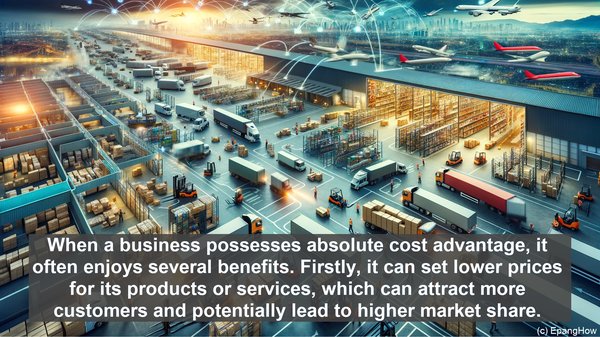Introduction: The Significance of Cost Advantage
Hello everyone, and welcome to today’s article. In the realm of economics, cost advantage is a term that frequently arises. It refers to the ability of a business or entity to produce goods or services at a lower cost compared to its competitors. This advantage can have a profound impact on market dynamics, profitability, and even international trade. Today, we’ll be focusing on two specific types of cost advantage: absolute and relative. While they may sound similar, they have distinct characteristics and implications. So, let’s dive in!
Absolute Cost Advantage: A Definition
To start, let’s define absolute cost advantage. It’s a situation where a business can produce a good or service at a lower cost than any other competitor, regardless of the scale of production. In other words, it’s a pure cost advantage, independent of any external factors. This advantage can arise due to various reasons, such as access to cheaper raw materials, advanced technology, or highly efficient production processes. The key point here is that the cost advantage is inherent to the business itself, making it a potent competitive tool.
Relative Cost Advantage: A Comparative Perspective
Now, let’s shift our focus to relative cost advantage. As the name suggests, this type of advantage is based on a comparison with other businesses or entities. It’s not about having the absolute lowest cost, but rather about having a lower cost compared to competitors. This advantage can be influenced by factors such as economies of scale, specialization, or even geographical location. While absolute cost advantage is about being the best in terms of cost, relative cost advantage is about being better than the rest.
Implications of Absolute Cost Advantage
When a business possesses absolute cost advantage, it often enjoys several benefits. Firstly, it can set lower prices for its products or services, which can attract more customers and potentially lead to higher market share. Additionally, it can generate higher profits per unit sold, as its cost per unit is lower. This advantage can also act as a barrier to entry for new competitors, as replicating the low cost structure can be challenging. However, it’s important to note that absolute cost advantage is not static. It can erode over time due to changes in factors like technology or input costs.

The Dynamics of Relative Cost Advantage
In the case of relative cost advantage, the implications are slightly different. While it may not provide the same level of market dominance as absolute cost advantage, it can still be a significant factor in competitiveness. For example, a business with a lower cost structure can offer more competitive prices, which can attract price-sensitive customers. Additionally, it can invest in areas like research and development or marketing, further enhancing its competitive position. However, it’s important to constantly monitor the market, as competitors can also strive to improve their cost structures, potentially diminishing the relative advantage.
Real-World Examples: Absolute vs Relative Cost Advantage
To better understand these concepts, let’s consider a couple of real-world examples. Take the automobile industry. A company like Tesla, with its advanced manufacturing processes and vertically integrated supply chain, enjoys an absolute cost advantage. This allows it to produce electric vehicles at a lower cost compared to many traditional automakers. On the other hand, a company like Toyota, with its extensive global supply network and economies of scale, has a strong relative cost advantage. While it may not have the absolute lowest cost, it can still produce vehicles at a lower cost compared to many competitors.

